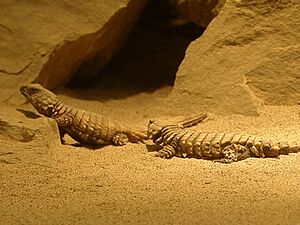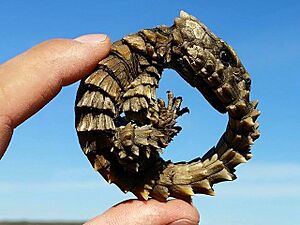Armadillo girdled lizard facts for kids
Quick facts for kids Armadillo girdled lizard |
|
|---|---|
 |
|
| Armadillo girdled lizards in Wuppertal Zoo | |
| Conservation status | |
| Scientific classification | |
| Genus: |
Ouroborus
|
| Species: |
cataphractus
|
| Synonyms | |
|
|
The armadillo girdled lizard (Ouroborus cataphractus) is a unique type of lizard. It's also known as the armadillo lizard or golden-armadillo lizard. This lizard lives only in the desert areas along the western coast of South Africa. It belongs to a family of lizards called Cordylidae. In 2011, scientists gave it its own special group, or genus, called Ouroborus, based on new discoveries about its family tree. Before that, it was in the Cordylus group.
Contents
What Does It Look Like?
The armadillo girdled lizard has a cool look! It can be light brown or dark brown. Its belly is yellow, often with black marks, especially under its chin.
These lizards are quite small. They usually grow to be about 7.5 to 9 centimeters (3 to 3.5 inches) long, not counting their tail. The longest they might get is around 8 inches (20 centimeters) from their snout to the base of their tail.
Where Does It Live?
The armadillo girdled lizard lives only in the Succulent Karoo biome in South Africa. This area is found in the Northern and Western Cape provinces. You can find them from the southern Richtersveld to the Piketberg Mountains and the southern Tankwa Karoo.
They like to live among rocks and on mountain slopes. They especially prefer places with sandstone rocks.
How Does It Live?
What Does It Eat?
The armadillo girdled lizard mainly eats small invertebrates. These include insects and spiders. Sometimes, they might also nibble on plants.
When kept as pets, they often eat crickets. In the wild, their favorite food is termites. They especially like Microhodotermes viator and Hodotermes mossambicus termites. Lizards living in bigger groups tend to eat more termites.
How Does It Behave?
The armadillo girdled lizard is diurnal, meaning it is active during the day. When it needs to hide, it finds shelter in cracks and small spaces within rocks.
These lizards live in social groups. A group can have anywhere from 30 to 60 lizards of all ages, but usually there are fewer. Male lizards are territorial. This means they protect an area and mate with the females living there.
One of the most amazing things about this lizard is how it protects itself. When it gets scared, it rolls into a tight ball. It even grabs its tail in its mouth! In this position, its thick, square-shaped scales and spiny tail protect it from predators. This special defense reminds people of the mythical ouroboros (a snake eating its own tail) and the mammalian armadillo. That's how it got its name!
How Does It Reproduce?
Female armadillo girdled lizards do not lay eggs. Instead, they give birth to one or two live young. This is quite rare for a lizard! Even more unusual, the mother lizard might even feed her young.
Females usually give birth only once a year. Some females might even take a year off between births.
Is It Endangered?
The IUCN (International Union for Conservation of Nature) lists the armadillo girdled lizard as "near threatened." This means it could become threatened in the future.
One big reason for this was people collecting them for the pet trade. This used to be a big problem, but now it's illegal. The lizard's numbers were greatly affected by this.
Today, the armadillo girdled lizard is also sensitive to changes in its main food source, termites. Termite populations can be affected by changes in weather, like rainfall. Also, their habitat can be harmed by invasive plants and poor fire management.



